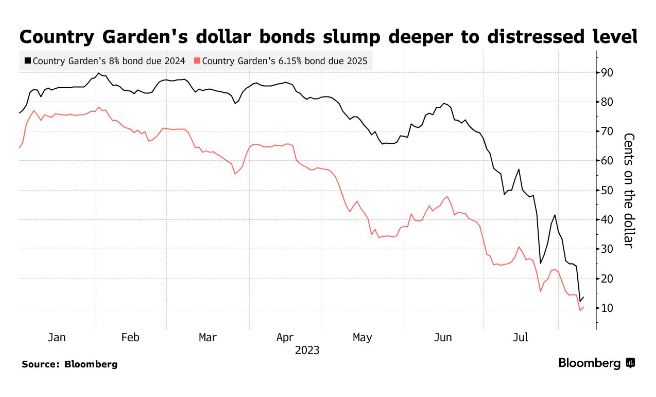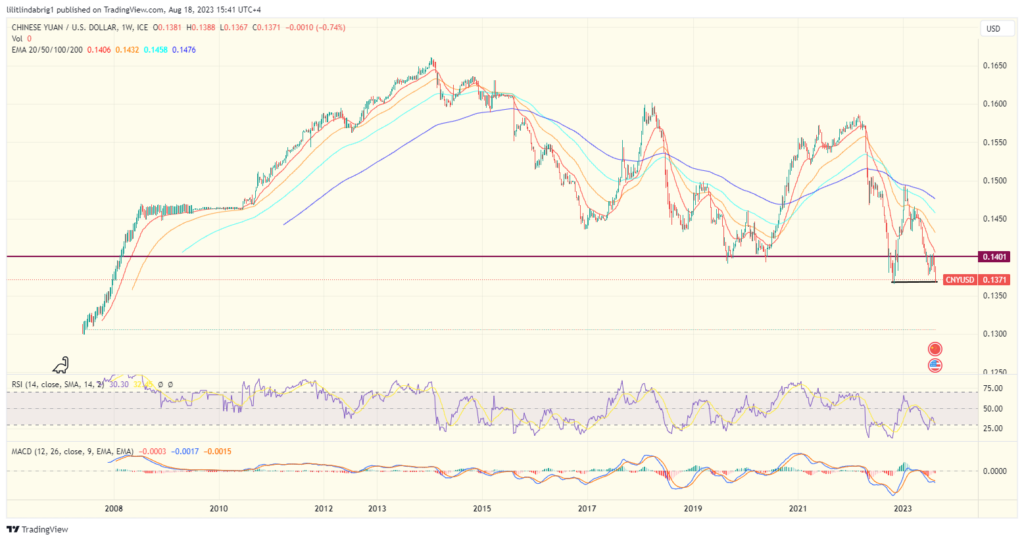Key Takeaways:
- People’s Bank of China injected $36 billion of liquidity in 48 hours via Reverse Repo.
- The economy is in trouble, exacerbated by the Evergrande bankruptcy filed in a US court.
- As a result, Yuan dropped 1.5% in two days.

YEREVAN (CoinChapter.com) — China liquidity Injections via Reverse Repo stood at 168 billion Yuan (CNY), or approximately $23 billion, on Aug 17, decreasing to 98 billion CNY on Friday, Aug 18 (just over $13 billion).
In detail, A reverse repurchase agreement (RRP), or reverse repo, is the sale of securities with the agreement to repurchase them at a higher price at a specific future date. People’s Bank of China conducted reverse repo operations through interest rate bidding to keep the liquidity in the banking system adequate at a “reasonable level.”

The previous 48 hours saw the largest spike in liquidity injections since February 2023, signaling troublesome deflationary territory. The headline CPI is now negative for the first time since early 2021, at -0.3%.
While several US and European publications underscored the role of poor management in China’s economic woes, embattled developer China Evergrande Group might have had an immediate impact.
Evergrande files for bankruptcy – building sector woes are far from over
As announced on Aug 18, China Evergrande Group has filed for bankruptcy protection in a US court as part of one of the world’s biggest debt restructuring exercises worth $32 billion. In detail, before 2021, Evergrande was the spearhead of China’s building boom.
However, the real estate firm’s default on its massive debt slammed global stock markets in early Sept 2021. In the latest filings in New York, Tianji Holding and Scenery Journey, subsidiaries of Evergrande, filed for Chapter 15 protection.
Evergrande has been struggling to compile an offshore debt restructuring agreement for several months and put forth a proposal earlier in 2023. It offered creditors a choice to swap their debt into new notes issued by the company and equities in two subsidiaries, Evergrande Property Services Group and Evergrande New Energy Vehicle Group.
In July, however, Evergrande posted a combined loss of $81 billion for 2021 and 2022, prompting worries about the viability of the debt restructuring plan.
Will Country Garden follow Evergrande?
As previously reported, the repercussions of Evergrande’s collapse are not yet full-blown, as the crash could affect other builders. For example, a possible Country Garden crash could extend wider than the Evergrande fiasco.
The firm’s total liabilities at the end of last year stood at 1.4 trillion Yuan, or nearly $200 billion. If Country Garden fails to repay within a 30-day grace period, it will also be on course for a public default.

In detail, the construction giant built over 3,000 housing projects, with 60% of its projects located in so-called Tier 3 and Tier 4 cities, which usually have a smaller population and weaker housing demand. Bloomberg Intelligence analyst Kristy Hung commented on the implications for the housing market if Country Garden slumps.
Any default would impact China’s housing market more than Evergrande’s collapse as Country Garden has four times as many projects. Debt crisis at [the company] will have a far-reaching impact on China’s housing market sentiment and could significantly weaken buyer confidence in solvent private developers.
said the expert.
Yuan drops near 15-year low before retesting a support line
Overall, the unprecedented debt crisis in the property sector, which accounts for roughly a quarter of the economy, exacerbated the anxiety over the weakening economy.
Additionally, the liquidity influx pushed Yuan to $0.13, or near a 15-year-low against the US dollar, before a tamed 0.33% uptick. The overall drop stood at 1.5% in the previous two days.

Should the liquidity influx continue, the People’s Bank of China risks dumping Yuan even lower.


